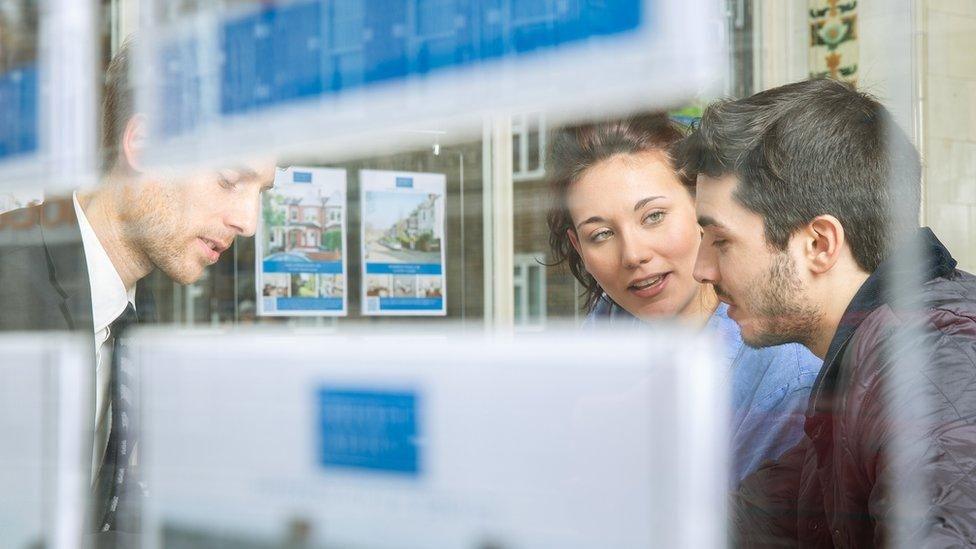Stamp duty: What is it and how much is it?

- Published
Stamp duty is a tax paid by most home buyers in England and Northern Ireland, with Scotland and Wales having similar levies, but its future has been the subject of much speculation.
The Institute for Fiscal Studies, an independent economic think tank, has described the duty as "one of the most economically damaging taxes".
In October, Kemi Badenoch said a future Conservative government would abolish stamp duty on the purchase of main homes.
What is stamp duty and who needs to pay it?
Stamp Duty Land Tax (SDLT) is a tax due if you buy a property or land over a certain price in England and Northern Ireland, external.
You have to pay the tax when you:
buy a freehold property
buy a new or existing leasehold
buy a property through a shared ownership scheme
take on a mortgage or buy a share in a house
The amount of stamp duty you owe depends on the cost of the property, whether it will be used for residential purposes, and whether you own any other property.
How much is stamp duty?
The current stamp duty rates are:
£0-£125,000 (£300,000 for most first-time buyers) = 0%
£125,001-£250,000 = 2%
£250,001-£925,000 = 5%
£925,001-£1.5m = 10%
£1.5m+ = 12%
The threshold for those buying their first property is £300,000 when buying a home of less than £500,000. If the price is over £500,000, first-time buyers cannot claim the relief.
Between September 2022 and the end of March 2025, the 0% threshold was more generous. Between these dates, buyers of homes worth less than £250,000 did not pay any stamp duty, while first-time buyers did not pay duty on the first £425,000 (when buying a home of less than £625,000).
If you already own a residential property worth £40,000 or more, and you buy another (or a part of one), you also have to pay an additional amount on top of the normal rates, external.
This rate is another 5% on properties worth up to £125,000, with higher rates for more expensive purchases.
Firms which buy dwellings worth more than £500,000 have to pay a single rate of stamp duty of 17%.
How much money does the government raise from Stamp Duty Land Tax?
SDLT raised £11.6bn for the government in the 2023-24 financial year, external, down from £15.4bn in 2022-23.
Of this, £8.6bn was due to residential property purchases in 2023-24, down from £11.7bn in 2022-23.
What do property buyers pay in Scotland?
In Scotland, the current rates for the Land and Buildings Transaction Tax, external (LBTT) are:
£0-£145,000 (£175,000 for first-time buyers) = 0%
£145,001-£250,000 = 2%
£250,001-£325,000 = 5%
£325,001-£750,000 = 10%
£750,001+ = 12%
Purchasers who already have a residential property also have to pay an Additional Dwelling Supplement (ADS), external on top of LBTT if their share of the new property is worth £40,000 or more. The ADS is 8% of the purchase price.
This includes people buying a second home, a rental property or a holiday home.
In December 2024, the Scottish government announced a review of the current LBTT rules would start in spring 2025.

What do property buyers pay in Wales?
In Wales the current standard rates for Land Transaction Tax, external (LTT) are:
£0-£225,000 = 0%
£225,001-£400,000 = 6%
£400,001-£750,000 = 7.5%
£750,001-£1.5m = 10%
£1.5m + = 12%
There is no first-time buyers' relief in Wales.
Purchasers usually have to pay a higher rate of LTT if they:
buy a residential property worth £40,000 or more, and
already own one or more other properties
The higher rates of LTT are:
£0-£180,000 = 5%
£180,001-£250,000 = 8.5%
£250,001-£400,000 = 10%
£400,001-£750,000 = 12.5%
£750,0001-£1,500,000 = 15%
£1.5m + = 17%
When do you have to pay stamp duty?
You have 14 days to pay stamp duty from the date of completion in England and Northern Ireland, external.
In Scotland and Wales you have 30 days from the point of purchase to pay the tax due.
If it takes longer, you could face a fine, or be charged interest on the amount you owe.
How do you pay stamp duty?
House buyers often pay via their solicitors, but you can also pay directly online, or by cheque or cash in many banks.
It is also possible to add stamp duty to mortgage loans and increase your debt to cover the cost of the tax, but you could end up paying significantly more in interest payments.